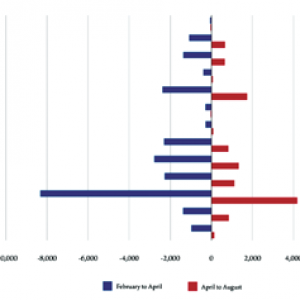Commercial
Billings Heights Post #6774/Lennick Bros. Roofing & Sheetm, 637 Anchor St, Com Fence/Roof/Siding, $8,600
Seahorse Gaming Llc/Yellowstone Basin Construction, 1918 Grand Ave, Com Fence/Roof/Siding, $95,000
1116 Grand Ave Llc/Perfect 10 Roofing & Construction, 1116 Grand Ave, Com Fence/Roof/Siding, 70,000
Winchell Real Estate Holdings/Cooper Construction, 1807 Grand Ave, Com Fence/Roof/Siding, $9,000
Roland & Michelle Wright, 3839 Grand Ave, Com Remodel, $1,200
Family Services/Cis Cornerstone Inspection Services, 3931 1st Ave S, Com Remodel, $70,000
T.W. Clark Construction Llc/1127 Alderson Llc, 1127 Alderson Ave, Com Remodel – Change In Use , $1,300,000
Kairos Properties Llc, 221 N 15th St, Com Remodel, $128,045
Kairos Properties Llc, 321 N 15th St, Com Remodel, $110,000
Kairos Properties Llc, 421 N 15th St, Com Remodel, $110,000
Kairos Properties Llc, 521 N 15th St, Com Remodel, $122,485
Kairos Properties Llc, 621 N 15th St, Com Remodel, $116,039
Horizon Retail Construction/ Future Equity Partners, 2450 King Ave W, Com Remodel, $11,500
VTR Properties Llc , 615 S 27th St, Com Remodel, $80,600
Ross Alger Holdings Llc /Van Arsdale, Duane Constr Inc, 2147 Poly Dr, Com Remodel, $10,000
Hays, Christoper J, 1148 Blair Ln, Com Remodel, $0.00
Et Properties Llc/Wagenhals Enterprises Inc, 10 N 35th St, Com Remodel, $40,000
Noraca Llc/Laughlin Construction Inc., 100 N 27th St, Com Remodel, $200,000
City Of Billings (Airport)/ Yellowstone Electric Co., 501 North View Dr, Com Remodel, $0.00
Elevation Church Billings, Inc /Snowy River Construction, 711 4th Ave N, Com Remodel, $8,300
Tanner Bennion/Jorden Construction, 848 Main St, Com Remodel, $6,000
The Billings Gazette /Lennick Bros. Roofing & Sheetm, 501 N22nd St, Com Fence/Roof/Siding, $8,600
JTA Ventures Llc/Sprague Construction Roofing Division, 1246 Central Ave, Com Fence/Roof/Siding, $60,000
Veeder Homestead Llc, 2225 Overland Ave, Com New Hotel/Motel, $12,000,000
Stockland Properties Inc, 15 Avanta Way, Com Remodel $500,000
Sisters Of Charith of Leavenwo/Saunders Construction Inc, Com Remodel, 1233 N30th St, $200,000
Sisters Of Charith of Leavenwo /Saunders Construction Inc, 1233 N30th St Com Remodel $1,000,000
McDonald Land Holdings Llc /Huppert Construction Company, 1310 Main St, Demolition Permit Commercial $5,000
Fagg Family Properties Llc/Huppert Construction Company, 205 N32nd St,
Demolition Permit Commercial, $5,000
Residential
Ryan W & Kristina D Morton /Northwest Construction, 2160 Skyview Dr, Res New Accessory Structure, $36,864
Mccall Development Inc/Mccall Development, 1820 Annas Garden Ln, Res New Single Family, $197,525
Mccall Development Inc/Mccall Development, 6033 Norma Jean Ln, Res New Single Family, $221,434
Wells Built Inc /Wells Built Inc., 4205 Snowywoods Dr, Res New Single Family, $398,227
Magnus Land Development Llc/Brown Builders Inc., 6319 Absaloka Ln, Res New Two Family, $327,260
Magnus Land Development Llc/ Brown Builders Inc., 6313 Absaloka Ln, Res New Two Family, $327,260
Pelzel, Bruce K & Yvette M/CMW Construction, 627 Valle Vista Ave, Res New Accessory Structure, $45,000
Taylor, Zachary J/Buscher Construction Ltd, 3116 Falcon Cir, Res New Single Family, $211,609
Taylor, Zachary J/Buscher Construction Ltd, 3118 Falcon Cir, Res New Single Family, $211,609
Infinity Home Llc/Infinity Home, 5134 Chapel Hill Dr, Res New Single Family, $198,600
Shriners Hospitals For Children/Dirk Arnold Construction, 1555 Tania Cir, , Res New Single Family, $221,018
Pierson Jensen Construction Co/ Wagner, Garret & Stephanie, 1017 Vineyard Way, Res New Single Family, $410,082
Joshua & Karen Graber/Hill Builders, 1880 Gleneagles Blvd, Res New Single Family $288,000
Billings Best Builders Llc/Starks R.E.Group, 917 Mission Oaks Dr, Res New Two Family, $442,320
Larry Wagoner,4183vaughn Ln, Res New Accessory Structure, $246,800
Nielsen,Rod&Juleen/Steve Gountanis Homes Inc, 933 Vineyard Cir, Res New Accessory Structure, $19,200
Uednyquist,Sverre & Saran/B & W Builders, 736 Ave N, Res New Accessory Structure, $32,256.00
Big Time Construction/Big Time Construction, 1407 Tania Cir, Res New Single Family, $216,544
David Mutch Yellowstone Property Solutions Llc 5211clemson Dr Res New Single Family $246,800.00
Res New Single Family Habitat For Humanity Newsfr1212 Spring Cir Habitat For Humanity,Midyell$201,072.00
Res New Single Family 6113 Norma Jean Ln McCall Development Inc $230,680.00
Res New Single Family McCall Development 6033farmstead Ave McCall Development Inc $224,174
McCall Development Inc/McCall Development, 6009 Farmstead Ave, Res New Single Family, $140,650
McCall Development Inc/McCall Development, 6039 Farmstead Ave, Res New Single Family, $222,024
Hanser Capital Holdings Llc/Hg Designs, 2706 Cornell Cir, Res New Single Family, $350,000
McCall Development Inc/McCall Development, 6015 Farmstead Ave, Res New Single Family, $140,650
Wagenhals Land And Livestock/Wagenhals Enterprises Inc, 1118 Daylight Ln, Res New Single Family, $260,000.00
Regal Land Development Inc/Teske Construction Inc, 4217 Bell Ave, Res New Two Family, $408,076
Wells,Daniel & Julane/Teske Construction Inc, 4223 Bell Ave, Res New Two Family, $435,340



